The Wild Boar (Sus Scrofa)
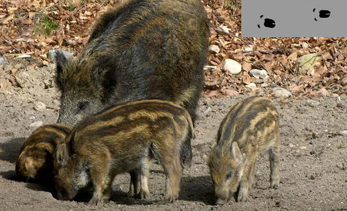 As an omnivore, the wild boar is rummaging the ground with its beak all by eating acorns, beech-nuts, roots, mushrooms, worms and grubs, young birds and carrion. His favourite habitat is the deciduous and mixed forest. From time to time the wild boar is haunting the fields and pastures, all by causing serious damages.
As an omnivore, the wild boar is rummaging the ground with its beak all by eating acorns, beech-nuts, roots, mushrooms, worms and grubs, young birds and carrion. His favourite habitat is the deciduous and mixed forest. From time to time the wild boar is haunting the fields and pastures, all by causing serious damages.
The fox (Vulpes vulpes)
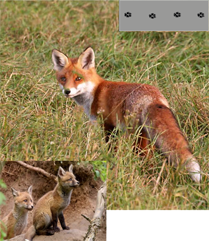 The fox mainly lives on the borders of the forest, but you can also find him in the fields. He is hunting predominately birds, insects and worms but also fruit, berries and seed. As the major transmitters of the canine madness foxes had been hunted intensively for many years. He proliferates the Echinococcus multilocularis.
The fox mainly lives on the borders of the forest, but you can also find him in the fields. He is hunting predominately birds, insects and worms but also fruit, berries and seed. As the major transmitters of the canine madness foxes had been hunted intensively for many years. He proliferates the Echinococcus multilocularis.
The badger (Meles meles)
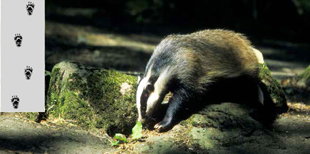 The badger is an omnivore and mainly active at night, prefering to live in deciduous and mixed forests. His sight is quite low but his scent and hearing however are very developed. The pairing season is from July to August and the young badgers (2 or 3, max. 5) are born in February/March. The den is always very clean, on the contrary of the fox’s, and is constructed on several floors with a developed tunnel system, often occupied by “lodgers” (fox and rabbit).
The badger is an omnivore and mainly active at night, prefering to live in deciduous and mixed forests. His sight is quite low but his scent and hearing however are very developed. The pairing season is from July to August and the young badgers (2 or 3, max. 5) are born in February/March. The den is always very clean, on the contrary of the fox’s, and is constructed on several floors with a developed tunnel system, often occupied by “lodgers” (fox and rabbit).
Red Deer (Cervus elephus)
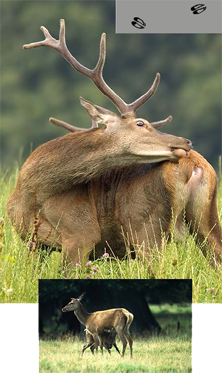 As the biggest native animal specie the Red Deer is mainly living on large woodlands, as the Grünewald for example. Once the specie also lived on the open land but with the humans taking more and more space for agriculture, the animals had to retrench into the woods. The deer spend their daytime in their favourite location, which they are leaving at night. They eat several times a day herbs, grass, berries, barks, pins and leaf. They need a very large habitat, also because they go for season linked migrations.
As the biggest native animal specie the Red Deer is mainly living on large woodlands, as the Grünewald for example. Once the specie also lived on the open land but with the humans taking more and more space for agriculture, the animals had to retrench into the woods. The deer spend their daytime in their favourite location, which they are leaving at night. They eat several times a day herbs, grass, berries, barks, pins and leaf. They need a very large habitat, also because they go for season linked migrations.
Roe Deer (Capreolus capreolus)
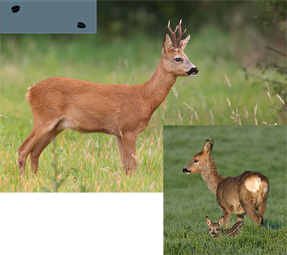 The Roe Deer are the most scattered animal specie of the Grünewald. They are living on pastures, fields and in the forest. Only the male Roe deer wears horns. They are eating graminae and herbs but also tree and bush buds. The animal is mainly active at dawn and dusk. In May 1 or 2 (rarely 3) fawns are born.
The Roe Deer are the most scattered animal specie of the Grünewald. They are living on pastures, fields and in the forest. Only the male Roe deer wears horns. They are eating graminae and herbs but also tree and bush buds. The animal is mainly active at dawn and dusk. In May 1 or 2 (rarely 3) fawns are born.
The hare (Lepus europaeus)
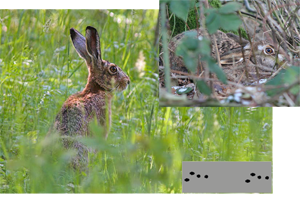 The hare is mainly living on pastures and fields, but sometimes you can also find him in the wood. He eats graminae and herbs, but as well barks and tree or bush buds. The development of agriculture engendered a poorly structured habitat and the survival of the hare is compromised.
The hare is mainly living on pastures and fields, but sometimes you can also find him in the wood. He eats graminae and herbs, but as well barks and tree or bush buds. The development of agriculture engendered a poorly structured habitat and the survival of the hare is compromised.
